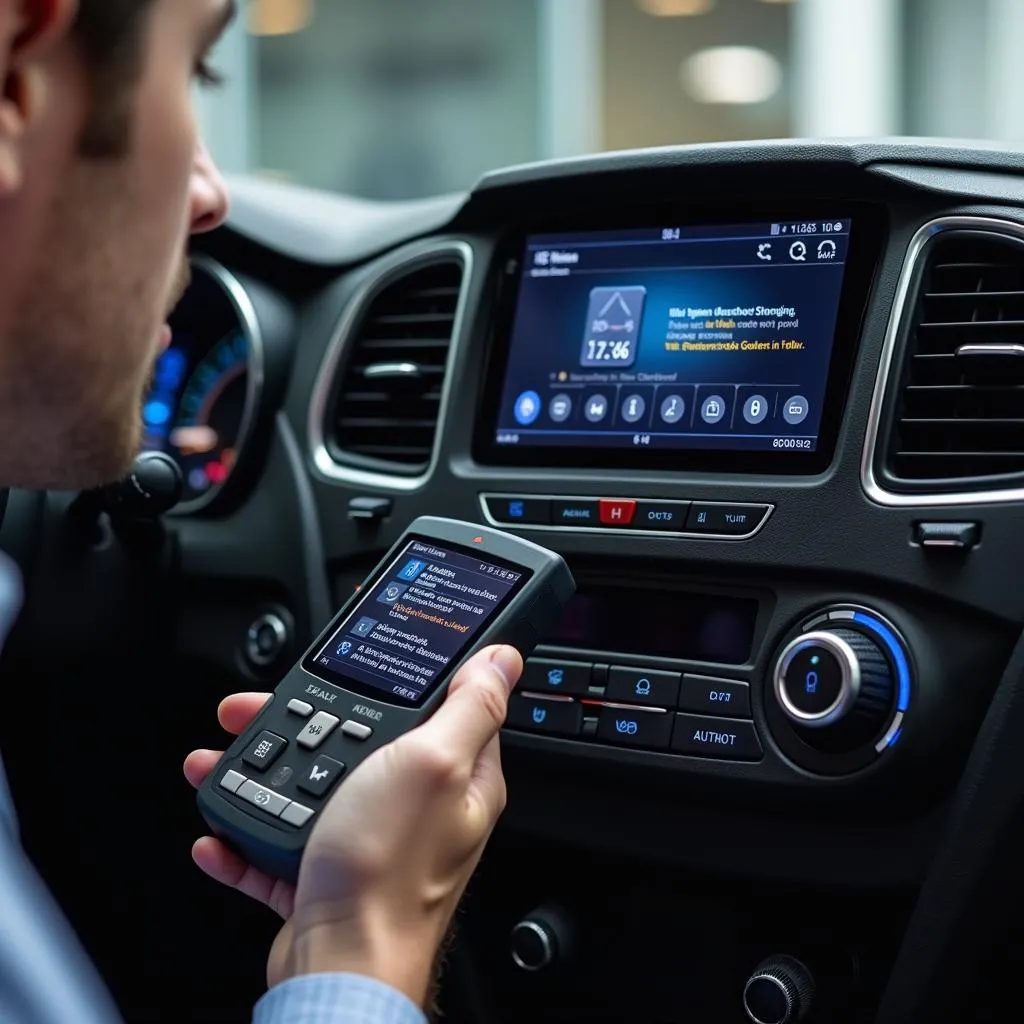Seeing both brake warning lights illuminated on your dashboard can be a nerve-wracking experience. This alarming sight usually indicates a serious issue with your braking system, demanding immediate attention. Understanding the potential causes and solutions is crucial for maintaining your safety and the longevity of your vehicle. Let’s delve into the common reasons behind this double warning and explore the steps you can take to address the problem.
Understanding Your Brake Warning Lights
Most vehicles have two primary brake warning lights: one for the standard hydraulic brake system and another for the Anti-lock Braking System (ABS). If only one light is on, the problem is likely isolated to that specific system. However, when both brake warning lights are on, it signifies a more complex issue that may affect both systems. This could range from low brake fluid levels to a serious malfunction in the ABS control module. Ignoring these warnings can lead to dangerous driving conditions, including brake failure.
2005 ford ranger both brake warning lights
Common Causes of Both Brake Lights On
Several issues can trigger both brake warning lights. These include:
- Low Brake Fluid: This is the most common culprit. Low brake fluid can be due to leaks in the brake lines, worn brake pads, or a faulty master cylinder.
- Faulty ABS Module: The ABS module controls the anti-lock braking system. If it malfunctions, it can trigger both warning lights.
- Damaged Wheel Speed Sensors: These sensors monitor the speed of each wheel and relay information to the ABS module. A damaged sensor can disrupt the ABS system and illuminate both warning lights.
- Worn Brake Pads: While worn brake pads primarily affect the hydraulic braking system, they can indirectly trigger the ABS warning light in some vehicles.
- Electrical Issues: Wiring problems or a faulty brake light switch can also cause both lights to illuminate.
What to Do When Both Brake Warning Lights Are On
If you encounter this situation, prioritize safety:
- Pull over safely: Find a safe location away from traffic and turn on your hazard lights.
- Check your brake fluid level: Locate the brake fluid reservoir and check the fluid level. If it’s low, add brake fluid following the manufacturer’s recommendations.
- Inspect for leaks: Look for any signs of brake fluid leaks around the brake lines, calipers, and wheel cylinders.
- Avoid driving: If the brake fluid level is extremely low or you suspect a leak, do not drive the vehicle. Call a tow truck to transport your car to a qualified mechanic.
bmw 5 series brake pad warning light
Diagnosing the Problem
If adding brake fluid doesn’t resolve the issue, further diagnosis is necessary. This may involve using a diagnostic scanner to read the trouble codes stored in the vehicle’s computer.
“When both brake lights are on, it’s crucial to diagnose the issue promptly,” says Michael Stevens, a seasoned automotive electrical engineer. “Ignoring these warnings can lead to costly repairs and potentially dangerous driving situations.”
How Can Remote Software Services Help?
Modern vehicles heavily rely on software and electronic control units. In some cases, both brake warning lights may illuminate due to software glitches or outdated firmware in the ABS module. Remote software services can provide a solution by diagnosing and reprogramming these modules without physically visiting a workshop. This can save time and money, especially if the issue is software-related.
nissan qashqai brake warning light yellow
Preventing Brake Warning Light Issues
Regular maintenance is key to preventing brake problems. This includes:
- Regular brake inspections: Have your brakes inspected at least once a year or as recommended by your vehicle manufacturer.
- Brake fluid flushes: Flush your brake fluid every two to three years to maintain its effectiveness.
- Timely brake pad replacements: Replace your brake pads before they wear down completely.
“Preventative maintenance is the best way to avoid unexpected brake problems,” advises Emily Carter, a certified automotive technician. “Regular checks can identify potential issues early on, preventing them from escalating into major repairs.”
Conclusion
Both brake warning lights illuminating simultaneously signal a significant issue that requires prompt attention. By understanding the potential causes and taking the appropriate diagnostic and repair steps, you can ensure your safety on the road and maintain the proper functioning of your vehicle’s braking system. Don’t delay; address the problem immediately to avoid potential hazards. Both brake warning lights are your vehicle’s way of saying, “Get this checked now!”
mercedes active brake assist warning light
FAQ
-
Can I drive with both brake warning lights on? No, it’s highly unsafe to drive with both brake warning lights illuminated. It indicates a serious problem with your braking system.
-
What is the most common reason for both brake lights to come on? Low brake fluid is typically the most frequent cause.
-
How do I check my brake fluid level? Locate the brake fluid reservoir, usually a translucent plastic container, and check the fluid level against the minimum and maximum markings.
-
Can I add brake fluid myself? Yes, but be sure to use the correct type of brake fluid recommended by your vehicle manufacturer.
-
What should I do if I see a brake fluid leak? Do not drive the vehicle. Call a tow truck and have your car transported to a mechanic.
-
How much does it cost to fix both brake warning lights? The cost varies depending on the underlying cause, ranging from a simple brake fluid top-up to more expensive repairs like replacing the ABS module.
-
How can I prevent brake warning light issues? Regular brake inspections and maintenance, including brake fluid flushes and timely brake pad replacements, are crucial for preventing future problems.

